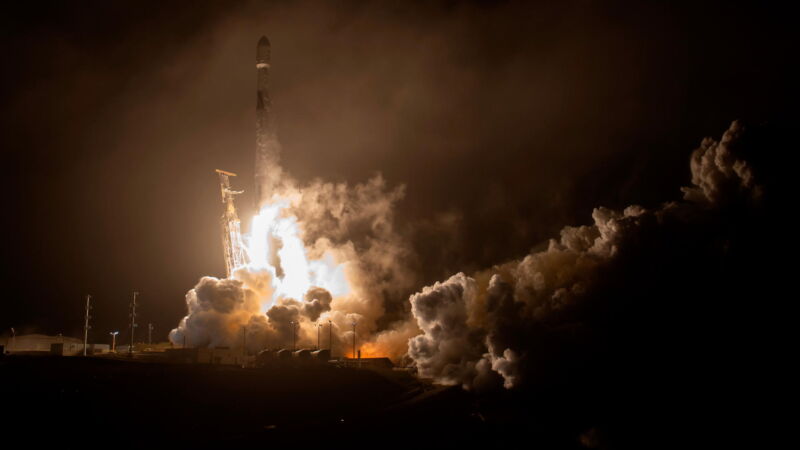Connecting with a fastball —
Slowing down an asteroid by just one-tenth of a second makes all the difference.

Enlarge / Riding atop a SpaceX Falcon 9 rocket, NASA’s Double Asteroid Redirection Test, or DART, spacecraft sets off to collide with an asteroid in the world’s first full-scale planetary defense test mission in November 2021.
On a fall evening in 2022, scientists at the Johns Hopkins University Applied Physics Laboratory were busy with the final stages of a planetary defense mission. As Andy Rivkin, one of the team leaders, was getting ready to appear in NASA’s live broadcast of the experiment, a colleague posted a photo of a pair of asteroids: the half-mile-wide Didymos and, orbiting around it, a smaller one called Dimorphos, taken about 7 million miles from Earth.
“We were able to see Didymos and this little dot in the right spot where we expected Dimorphos to be,” Rivkin recalled.
After the interview, Rivkin joined a crowd of scientists and guests to watch the mission’s finale on several big screens: As part of an asteroid deflection mission called DART, a spacecraft was closing in on Dimorphos and photographing its rocky surface in increasing detail.
Then, at 7: 14 pm, a roughly 1,300-pound spacecraft slammed head-on into the asteroid.
Within a few minutes, members of the mission team in Kenya and South Africa posted images from their telescopes, showing a bright plume of debris.
In the days that followed, researchers continued to observe the dust cloud and discovered it had morphed into a variety of shapes, including clumps, spirals, and two comet-like tails. They also calculated that the impact slowed Dimorphos’ orbit by about a tenth of an inch per second, proof-of-concept that a spacecraft—also called a kinetic impactor—could target and deflect an asteroid far from Earth.
The final five-and-a-half minutes of images from the DART spacecraft as it approached and then intentionally collided with asteroid Dimorphos. The video is 10 times faster than reality, except for the last six images.
NASA/Johns Hopkins APL/YouTube
Ron Ballouz, a planetary scientist at the lab, commented that what is often seen in the movies is a “sort of last-ditch-effort, what we like to call a final-stage of planetary defense.” But if hazardous objects can be detected years in advance, other techniques like a kinetic impactor can be used, he added.
If a deflection were necessary, scientists would need to change the speed of a hazardous object, such as an asteroid or comet, enough that it doesn’t end up at the same place and time as Earth as they orbit the Sun. Rivkin said this translates into at least a seven-minute change in the arrival time: If a Dimorphos-sized object were predicted to collide with Earth 67 years from now, for instance, the slow-down that DART imparted would be just enough to add up to the seven minutes, he added.
With less lead time, researchers could use a combination of multiple deflections, larger spacecrafts, or boosts in speed, depending on the hazardous object. “DART was designed to validate a technique, and specific situations would inevitably require adapting things,” said Rivkin.
Researchers use data from DART and smaller-scale experiments to predict the amount of deflection using computer simulations.
Scientists are also focusing on the type of asteroid that Dimorphos appears to be: a “rubble pile,” as they call it, because objects of this kind are thought to be made of clumps of many rocks.
In fact, scientists think that most asteroids the size of Dimorphos and larger are rubble piles. As scientists continue to learn more about rubble piles, they will be able to make better predictions about deflecting asteroids or comets. And in 2026, a new mission will arrive at Didymos and Dimorphos to collect more data to fine-tune the computer models.
In the meantime, researchers are trying to learn as much as possible in the unwelcome case an asteroid or comet is discovered to be a threat to Earth and a more rapid response is necessary.
Scientists first suspected that many asteroids are rubble piles about 50 years ago. Their models showed that when larger asteroids smashed into one another, the collisions could throw off fragments that would then reassemble to form new objects.
It wasn’t until 2005, though, that scientists saw their first rubble pile: asteroid Itokawa, when a spacecraft visited it and photographed it. Then, in 2018, they saw another called Ryugu, and later that year, one more, asteroid Bennu. DART’s camera also showed Didymos and Dimorphos are likely of the same variety.
“It’s one thing to talk about rubble piles, but another to see what looks like a bunch of rocks dumped off a truck up close,” said William Bottke, a planetary scientist at the Southwest Research Institute in Boulder, Colorado.